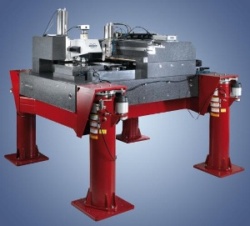Dec 11 2009
Bruker Nano today announced that its N8 TITANOS™ large-sample inspection AFM has been further improved to provide highest spatial resolving power. Due to its unique AFM technology and outstanding mechanical stability, the TITANOS has now been demonstrated with atomic-scale resolution on HOPG (highly oriented pyrolythic graphite) on a production instrument in standard configuration. The TITANOS has proven itself once again as the most precise and stable AFM platform for large samples up to 300 mm diameter.
 Bruker's N8 TITANOS Atomic Force Microscope (AFM) is capable of inspecting large wafers, for metrology on solar panels, photolithography masks, flat panel displays, etc
Bruker's N8 TITANOS Atomic Force Microscope (AFM) is capable of inspecting large wafers, for metrology on solar panels, photolithography masks, flat panel displays, etc
The N8 TITANOS has been developed for the inspection of 300 mm wafers, and it is also in use for metrology on solar panels, photolithography masks, flat panel displays, etc. The TITANOS’ ultra-precise xy-positioning stage employs contact-less linear motors, high-resolution glass encoders and an air bearing for fast, reproducible sample movement. The TITANOS AFM is mounted on a solid granite bridge above the platform.
All AFM systems offered by Bruker Nano employ Fiber Optic Interferometry (FOI) detection as a unique feature to achieve outstanding resolution even on large samples. “FOI provides superior sensitivity as well as a calibrated deflection,” explains Dr. Hans Achim Fuss, Bruker Nano’s AFM Chief Technology Officer. “The results obtained with our AFMs are highly reproducible due to the exact knowledge of all crucial parameters.”
Dr. Frank Saurenbach, Vice President for AFM at Bruker Nano commented further: “It is incredible to see the TITANOS’ stage move hundreds of millimeters in seconds, and then operate with such stability and record resolution at each new measuring position. We are excited to supply the large sample AFM tool with the highest resolving power available on the market”.
The N8 TITANOS can be used as a stand-alone, automated system or combined with a high-performance optical microscope. It comes as a fully accessible R&D tool, or can be upgraded to an at-line production inspection system.